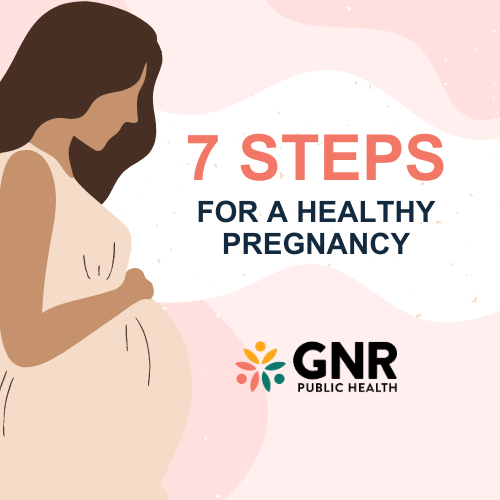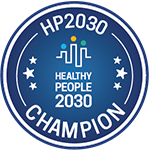
Perinatal Case Management
Off to a great start!
Perinatal (Pregnancy) Case Management, or PCM, helps ensure you and your baby have a healthy pregnancy. The health department can help you with pregnancy Medicaid and WIC applications and is valuable in giving your baby a healthy start.
7 Steps for a Healthy Pregnancy
Take the following steps to ensure you and your baby have the care you need. You’ll learn ways to keep you and your baby healthy before the baby’s arrival, during labor, and after your baby’s birth!
Step 1: Get health insurance if you do not have it.
The health department can help you apply for Pregnancy Medicaid.
If you are pregnant and eligible, you will get a Medicaid certification form on the same day that you apply. You will be able to get prenatal care for yourself and your baby immediately!
Once your application is approved, you’ll be assigned a care management organization, or CMO that will provide health services and coordinate your care. The CMO is a group of doctors, nurses, other staff, hospitals, and clinics that provide care.
Three CMOs, work with Georgia Families®. Click each link to learn more.
Amerigroup Community Care
CareSource
Peach State Health Plan
- Choose or change your Georgia Families® care management organization.*
*Restrictions may apply. Contact GA Families for more information. - Check the status of your application at GA Gateway.
Step 2: Get prenatal care.
- Choose a local provider to start your care.
Local provider lists:
Gwinnett County Providers
Newton County Providers
Rockdale County Providers - Know which tests you should receive and what to expect at your prenatal visits.
Learn about prenatal care and testing.
Tips for a healthy pregnancy
- Keep all of your appointments.
- Always discuss any health-related concerns with your medical provider. They want you and your baby to stay safe and healthy!
Step 3: Prevent pregnancy complications.
- Stop smoking.
Get help with smoking cessation:
Baby and Me Tobacco Free
Ready to Quit
Quit for You, Quit for Two - Take a prenatal vitamin containing folic acid to prevent neural tube defects.
Learn about the benefits of folic acid during pregnancy. - Stay up-to-date on vaccinations or get those that you are missing.
Discover recommended vaccines. - Ensure you get tested and treated for STIs when you have them.
Read how STIs can be harmful to you and your pregnancy. - Familiarize yourself with travel-related risks.
Read up on important information about Zika virus and pregnancy.
Step 4: Focus on healthy nutrition.
- Practice food safety.
-Wash hands and cooking surfaces.
-Cook foods to the right temperature.
-Refrigerate perishable food as soon as possible but never more than two hours at room temperature.
Get more food safety practices at FDA. - Maintain a healthy weight.
You’ll gain between 15 and 30 pounds during your pregnancy depending on your starting weight.
Read about healthy pregnancy weight gain, how to meet recommendations based on your starting weight, and download a tracker. - Enroll in WIC if eligible.
The health department can help pregnant women apply for WIC.
WIC, the Special Supplemental Nutrition Program for Women, Infants, and Children, provides food and other benefits for eligible pregnant women and children under age 5.
For questions or to enroll, call WIC at 770.513.9738.
Read more about the WIC.
Step 5: Be prepared to take action if you experience pregnancy complications.
- Learn the signs and symptoms of pre-term labor.
Call your OB/GYN or visit the ER, if you experience any of the following pre-term labor symptoms:
-Bleeding
-Cramping
-Pressure
-Fluid leakage
-Contractions
-Low backache
Learn if you are at risk for pre-term labor. - Get screened for common complications, or health problems, that can occur during pregnancy such as hypertension, pre-eclampsia, genetics, and gestational diabetes.
Read more about pregnancy complications. - Understand when it could be more than typical morning sickness. About 3 in 100 women may have extreme, excessive nausea and vomiting during pregnancy called hyperemesis gravidarum. It can cause you to lose weight and become dehydrated (not having enough water in your body). It can start early in pregnancy and last the entire pregnancy. If you have hyperemesis gravidarum, you need treatment to help keep you and your baby safe.
Call your OB/GYN, if you:
-Vomit 3-4 times a day
-Have decreased urination
-Are unable to keep food or fluids down for longer than 24 hours
Learn more about morning sickness, including tips to prevent it and relieve its symptoms, and get more information on hyperemesis gravidarum. - Know when to track and report changes in your baby’s movement. You’ll start to monitor your baby’s movement to learn your baby’s pattern after week 28 of your pregnancy.
Call your OB/GYN if you notice a sudden decrease in movement.
Read more about why your baby’s movement is important or download an app to help you keep track.
Step 6: Make an after-delivery plan.
- Make a plan to follow in the event you experience post-partum depression or mood swings after the baby’s delivery.
According to CDC, post-partum depression affects 1 in 8 women.
If you have thoughts of harming yourself or your baby, ask for help. Call 988.
Download a postpartum depression fact sheet from the Office on Women’s Health. - Get breastfeeding information and support. Breastfeeding is beneficial to both mom and baby. See a breastfeeding educator for a free one-on-one consultation.
GNR Public Health Breastfeeding Support Services
La Leche League - Make a family planning visit to discuss your reproductive health and pregnancy prevention options.
Learn more about contraception so you can make the choice that is right for you.
Make an appointment at a GNR Public Health health center near you. - Establish a safe sleep environment for your baby.
- Give babies their own space in your room, separate from your bed.
- Use a firm, flat, and level sleep surface, covered in a sheet.
- Remove everything from the baby’s sleep area, except a fitted sheet to cover the mattress.
- Use a wearable blanket to keep the baby warm without blankets in the sleeping area.
- Place babies on their backs to sleep, for naps, and at night.
- Couches and armchairs are not safe for babies to sleep on.
- Keep baby’s surroundings smoke/vape free.
Download and print:
What does a safe sleep environment look like?
Safe sleep information for grandparents.
Step 7: Read as much as you can about having a healthy pregnancy.
Visit the following websites for more healthy pregnancy information:
American College of Obstetricians and Gynecologists
Call your OB/GYN if you have any questions or concerns with your pregnancy.
Learn about our other women’s services or make an appointment at one of our health centers today.










